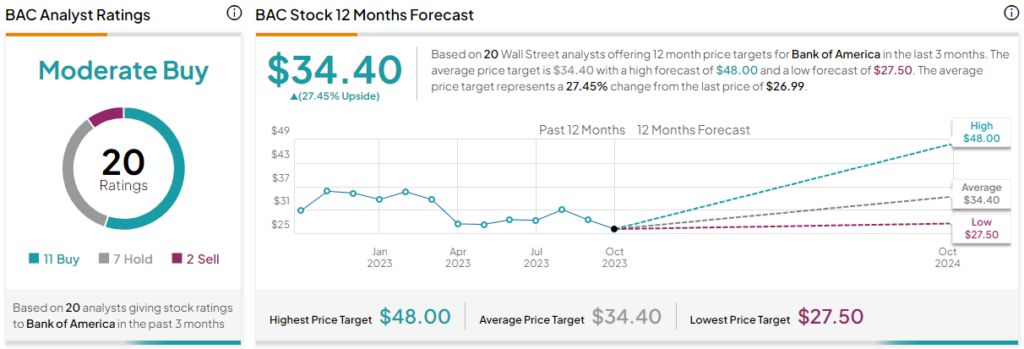Bank of America (NYSE:BAC) is one of the largest and most diversified financial institutions in the world. Perhaps it’s one that needs no introduction, and this may be another reason to look upon the stock favorably. BAC offers the full package of products and services — retail and commercial banking, investing, asset management, and other financial and risk management solutions. In this article, I’ll explain why I am bullish on Bank of America stock and why I think it could be a Buy this October and beyond.
Elevate Your Investing Strategy:
- Take advantage of TipRanks Premium at 50% off! Unlock powerful investing tools, advanced data, and expert analyst insights to help you invest with confidence.
To put it simply, Bank of America has an attractive valuation compared to its peers and the market. The company’s stock is trading at lower multiples than the average for its peer group of banking companies and the S&P 500 Index (SPX). BAC also has strong fundamentals and growth prospects.
I believe investors should consider adding Bank of America stock to their portfolios as the company continues to deliver on growth and profitability at a low valuation.

Why Things Look Good for the Long Term
Bank of America is one of the most attractive bank stocks for long-term investors, as it has several factors that set it apart from other banks. The first factor is its size and scale, which enable it to offer the widest range of financial products in the banking sector, it does, after all, have some $2.5 trillion in assets. The second factor is its financial strength, which is reflected in its high liquidity, capital, and regulatory ratios.
According to the bank’s press release regarding its stress test, Bank of America has ample liquidity from various global sources and a Common Equity Tier 1 (“CET1”) ratio of 11.6% as of June 30, 2023, well above the minimum requirement of 9.5% that has been effective from October 1, 2023. The bank also announced that it will increase its CET1 requirement by another 0.5% starting in 2024, further enhancing its financial stability.
Attractive Growth, Profitability, and Valuation
Growth
Bank of America has shown consistent growth in both the short and long term. In the past year, it managed to increase its revenue by 5.6%, its earnings per share (EPS) by 8.8%, and its return on equity by 60 basis points. It achieved this by expanding its customer base, improving its efficiency, and reducing its expenses.
Moreover, Bank of America’s growth has been even stronger in the past five years. It grew its revenue by a compound annual growth rate (CAGR) of 2.5%, its net income by 6.7%, and its EPS by 12.8%. These growth figures are impressive, especially for a large and mature company like Bank of America. It shows that the bank has been able to grow its revenue and net income steadily over the years while also increasing its EPS significantly by buying back shares and reducing its equity.
Profitability
Last quarter, Bank of America delivered impressive results. It reported an increase of 11% year-over-year in revenue, which reached $25.2 billion, while reporting a jump of 19% year-over-year in net income, which reached $7.4 billion. It has a high net margin of 29.3%, meaning that it keeps almost a third of its revenue as earnings.
Additionally, Bank of America has demonstrated high returns on its capital. It reported an 11.2% return on equity, which assesses how well the bank uses its shareholders’ capital, and BAC sure does deploy capital efficiently. It reported a 15% return on tangible book value, which measures how well the bank generates profits from its tangible assets. These metrics are above the industry averages of 9% and 13%, respectively. Furthermore, Bank of America’s profitability has been consistent over the past few years.
Valuation
Bank of America is currently undervalued by several measures. At today’s prices, it trades at a low multiple of its earnings, sales, book value, and cash flow compared to its industry peers and to its intrinsic value. Specifically, it trades at the following multiples:
7.7 times earnings, lower than the industry average of 8.8 times earnings; 2.2 times sales, lower than the industry average of 2.9 times sales; 0.81 times book value, lower than the industry average of 1.0 times book value; 4.6 times operating cash flow, lower than the industry average of 6.0 times operating cash flow.
These valuation ratios indicate that Bank of America is trading at a discount to its peers and to its intrinsic value. It also has a low price-to-earnings growth (PEG) ratio of 0.585. A low PEG ratio (under 1.0 is considered low) means that the stock is cheap relative to its expected growth rate. Peter Lynch, one of the most successful investors of all time, would likely be very excited to see such a behemoth of a company trading at such a low PEG ratio.
Is BAC Stock a Buy, According to Analysts?
Turning to Wall Street, BAC has a Moderate Buy consensus rating based on eight Buys and three Holds assigned in the past three months. At $34.40, the average BAC stock forecast implies 27.36% upside potential.

Conclusion
Bank of America is a profitable, growing, and undervalued stock that deserves investors’ attention. It has delivered strong results in its most recent quarter and over the past year. It has also shown consistent growth in both the short and long term while also increasing its shareholder value through buybacks and dividends.
Further, it trades at a low multiple of its earnings, sales, book value, and cash flow compared to its industry peers. Therefore, I believe that Bank of America is a good stock to consider for seeking a solid and stable bank stock with upside potential.
















